Pulse Oximetry Market Size 2025-2029
The pulse oximetry market size is valued to increase USD 1.36 billion, at a CAGR of 8.5% from 2024 to 2029. Increasing prevalence of chronic respiratory diseases will drive the pulse oximetry market.
Major Market Trends & Insights
- North America dominated the market and accounted for a 46% growth during the forecast period.
- By Product - Bedside/desktop pulse oximeters segment was valued at USD 760.50 billion in 2023
- By End-user - Hospitals and clinics segment accounted for the largest market revenue share in 2023
Market Size & Forecast
- Market Opportunities: USD 104.23 million
- Market Future Opportunities: USD 1355.60 million
- CAGR from 2024 to 2029 : 8.5%
Market Summary
- The market represents a significant and continually evolving sector within the healthcare technology industry. This market is driven by the increasing prevalence of chronic respiratory diseases, such as sleep apnea and chronic obstructive pulmonary disease (COPD), which necessitate regular monitoring of oxygen saturation levels. Core technologies, including non-invasive sensors and wireless connectivity, are advancing to improve accuracy and convenience. Applications span various sectors, including hospitals, home healthcare, and remote patient monitoring. Service types, including sales, installation, and maintenance, are essential for market growth. Regulatory bodies, like the Food and Drug Administration (FDA), play a crucial role in market development through approval processes and guidelines.
- Despite these opportunities, limitations and complications associated with pulse oximeters persist. For instance, factors like motion artifacts and low perfusion states can affect accuracy. Additionally, the high cost of advanced pulse oximeters and the need for calibration pose challenges. As of 2021, the market holds a significant market share in the global point-of-care diagnostics market, with an estimated 30% share. The market's continuous evolution is shaped by ongoing technological advancements and increasing online marketing strategies by market companies.
What will be the Size of the Pulse Oximetry Market during the forecast period?
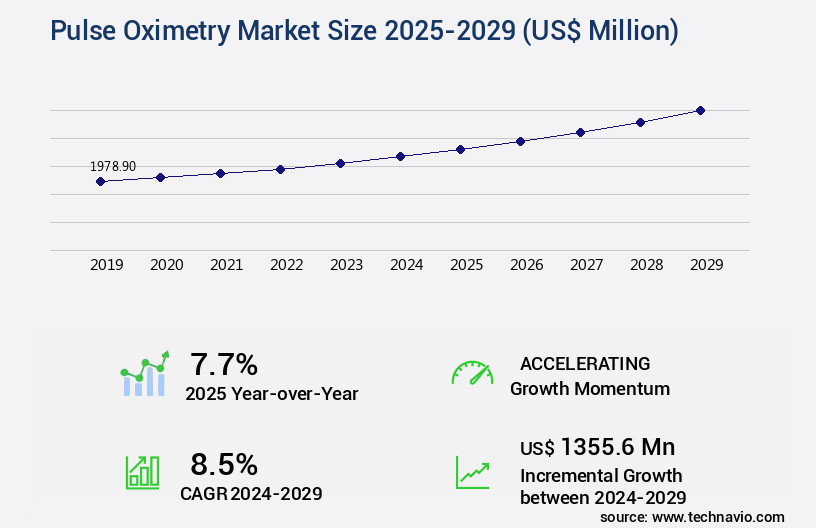
Get Key Insights on Market Forecast (PDF) Request Free Sample
How is the Pulse Oximetry Market Segmented ?
The pulse oximetry industry research report provides comprehensive data (region-wise segment analysis), with forecasts and estimates in "USD million" for the period 2025-2029, as well as historical data from 2019-2023 for the following segments.
- Product
- Bedside/desktop pulse oximeters
- Handheld pulse oximeters
- Fingertip pulse oximeters
- Wrist-worn pulse oximeters
- End-user
- Hospitals and clinics
- Alternative care settings
- Distribution Channel
- Geography
- North America
- Europe
- APAC
- China
- India
- Japan
- South Korea
- Rest of World (ROW)
By Product Insights
The bedside/desktop pulse oximeters segment is estimated to witness significant growth during the forecast period.
The market encompasses a range of patient monitoring systems, with handheld devices accounting for a significant second-share. These devices offer real-time oxygen saturation monitoring, respiratory rate detection, and heart rate monitoring through non-invasive, plethysmography technology. Handheld pulse oximeters are versatile, suitable for various applications from occasional spot checks to long-term studies, catering to both neonatal and adult patients in hospitals and home settings. Key features include adjustable alarm thresholds, calibration techniques, and user-friendly interfaces. Sensor accuracy validation is crucial, with considerations for sensor lifespan, performance benchmarks, and signal processing algorithms.
Ambient light interference and motion artifact reduction are essential for maintaining signal quality. Wireless connectivity, data logging capabilities, and maintenance procedures ensure seamless integration into clinical workflows. Safety standards and data transmission protocols further enhance these devices' reliability and usability.
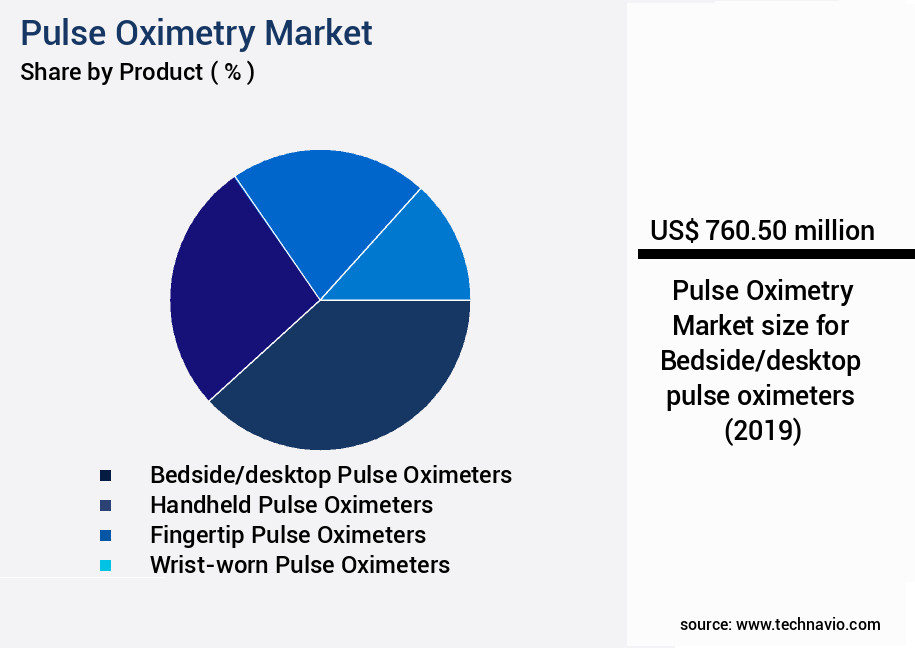
Request Free Sample
The Bedside/desktop pulse oximeters segment was valued at USD 760.50 billion in 2019 and showed a gradual increase during the forecast period.
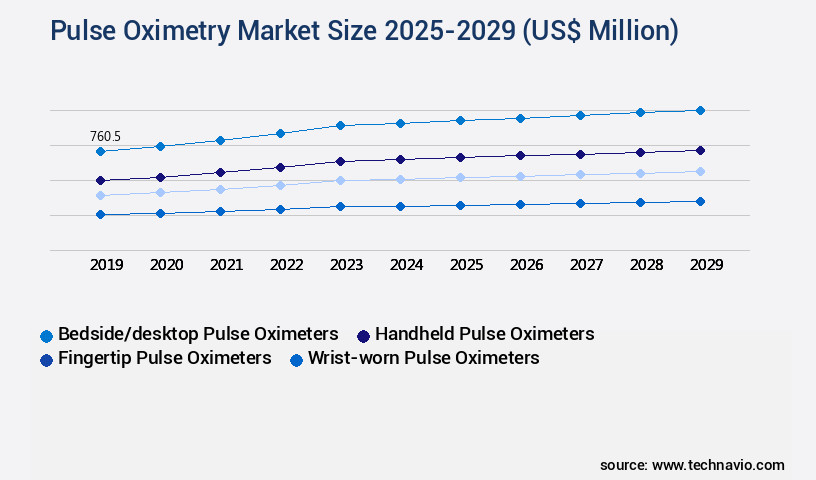
Request Free Sample
Regional Analysis
North America is estimated to contribute 46% to the growth of the global market during the forecast period.Technavio’s analysts have elaborately explained the regional trends and drivers that shape the market during the forecast period.
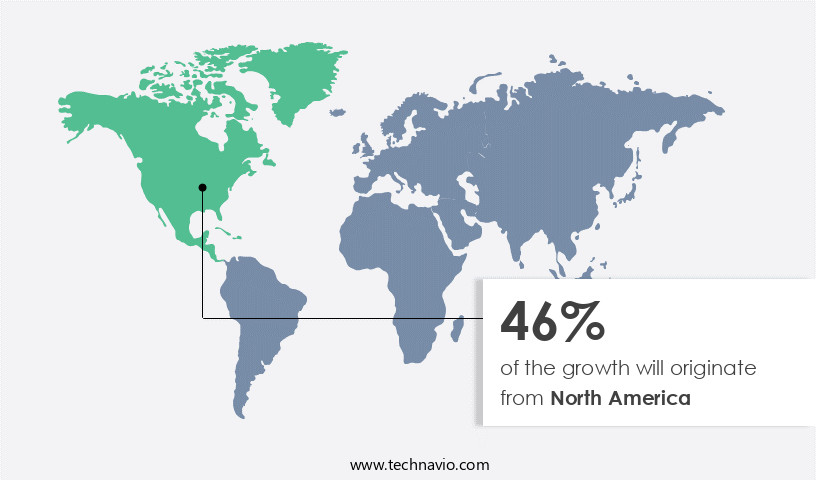
See How Pulse Oximetry Market Demand is Rising in North America Request Free Sample
The market in North America exhibits a robust expansion, with the United States and Canada being the primary contributors to its revenue. The market's growth is fueled by the high incidence of respiratory disorders and chronic diseases, leading to an increase in surgeries. Skilled physicians and advanced healthcare infrastructure further bolster the market's growth. Notable companies, including General Electric Co., Medtronic, Masimo, and Smiths Medical, significantly contribute to the region's market share.
These entities generate substantial revenues from North America, with a well-established supply chain ensuring the availability of innovative products.
Market Dynamics
Our researchers analyzed the data with 2024 as the base year, along with the key drivers, trends, and challenges. A holistic analysis of drivers will help companies refine their marketing strategies to gain a competitive advantage.
The market is a dynamic and evolving sector in the healthcare technology industry, driven by advancements in sensor technology, clinical applications, and integration with other medical devices. Pulse oximetry, a non-invasive method for measuring blood oxygen saturation (SpO2) levels, plays a crucial role in various clinical settings, from intensive care units to remote patient monitoring. Motion artifact and low perfusion are significant challenges in pulse oximetry, impacting accuracy. To mitigate these issues, researchers focus on calibration methods, signal processing techniques, and comparison of different pulse oximetry technologies. Calibration methods, such as multi-wavelength and multi-sensor approaches, aim to enhance accuracy in low perfusion conditions.
Signal processing techniques, including machine learning algorithms and advanced filtering methods, help minimize motion artifact. The integration of pulse oximetry with other medical devices, such as electronic health records (EHRs) and telemedicine platforms, broadens its clinical applications. In various settings, pulse oximetry is used for monitoring patients with respiratory disorders, anesthesia, and sleep apnea. Wireless communication protocols facilitate data transmission, enabling real-time monitoring and remote patient care. Design considerations for improving pulse oximetry sensor lifespan and user experience are essential. Advanced algorithms, miniaturization, and user-friendly interfaces are key areas of development. Regulatory compliance requirements, including FDA regulations, ensure the safety and efficacy of pulse oximetry devices.
The market is diverse, with numerous players focusing on various segments. More than 60% of new product developments target wearable applications, driven by the miniaturization of sensors and the increasing demand for remote patient monitoring. Despite these advancements, challenges persist, such as data security and privacy concerns, implementing pulse oximetry in remote patient monitoring, and the impact of ambient light on readings. Future trends include the use of artificial intelligence (AI) in pulse oximetry data analysis, validation studies in diverse populations, and performance evaluations under various conditions. As the market continues to grow, companies must stay informed about these trends to remain competitive.
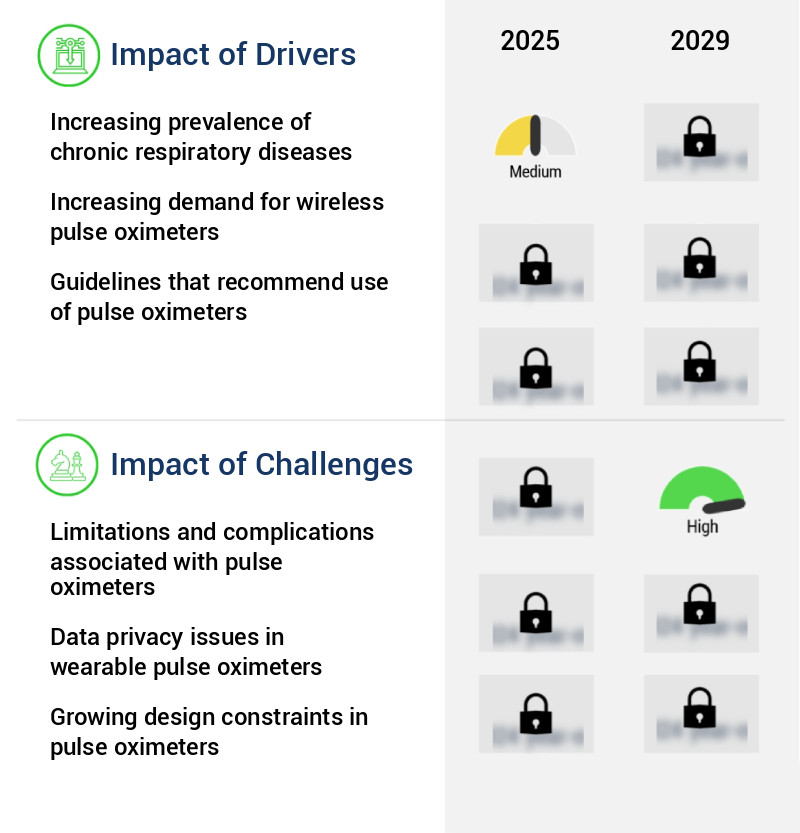
What are the key market drivers leading to the rise in the adoption of Pulse Oximetry Industry?
- The rising prevalence of chronic respiratory diseases serves as the primary market driver, significantly expanding the market scope.
- Pulse oximeters play a pivotal role in diagnosing and monitoring various respiratory conditions, including endotracheal intubation, cardiac arrest, procedural sedation, asthma, chronic obstructive pulmonary disease (COPD), acute respiratory distress syndrome (ARDS), sleep disorders like obstructive sleep apnea (OSA), and cyanotic congenital heart diseases. The global prevalence of chronic respiratory disorders is on the rise, particularly in low- and middle-income countries. Asthma, for instance, affects over 250 million people worldwide, with India accounting for approximately 13.1% of the global burden. COPD remains the third-leading cause of death worldwide.
- The incidence of obstructive sleep apnea is also increasing, underscoring the growing need for effective respiratory monitoring solutions. The continuous and evolving nature of the market reflects these ongoing health trends and the increasing demand for non-invasive, portable diagnostic tools.
What are the market trends shaping the Pulse Oximetry Industry?
- Market trends indicate an increasing adoption of advanced online marketing strategies by companies. This trend is mandatory for businesses seeking to remain competitive in today's digital marketplace.
- In response to the rising demand for pulse oximeters in home care settings, marketing strategies for these devices have shifted. Companies are expanding their online presence to boost sales. Masimo, among others, has established a significant online presence through social media platforms like Twitter and Facebook. This digital approach enables these companies to reach beyond traditional markets, including clinics and hospitals, and cater to the growing home-based healthcare sector.
- Various marketing tactics are employed to increase online sales, including targeted digital advertising and strategic partnerships with e-commerce platforms. The shift towards online marketing reflects the evolving nature of the pulse oximeter market, as companies adapt to changing consumer preferences and behaviors.
What challenges does the Pulse Oximetry Industry face during its growth?
- The pulse oximeter industry faces significant challenges due to the limitations and complications inherent in the technology, which include factors such as inaccuracies in readings for individuals with certain skin tones or conditions, motion artifact, and the need for calibration. These issues can impact the reliability and effectiveness of the devices, potentially hindering industry growth.
- Pulse oximetry, a non-invasive medical technology used to measure oxygen saturation levels in the blood, has gained widespread adoption across various healthcare sectors. However, it's essential to acknowledge the potential complications and limitations associated with this technology. Inaccurate readings can occur due to various factors, such as the presence of abnormal hemoglobin types like carboxyhemoglobin and methemoglobin, anemia, reduced peripheral circulation caused by vasoconstriction or peripheral vascular diseases, venous congestion, bright ambient light, and the use of nail varnish. Approximately 3-4% of pulse oximetry tests on critically ill patients receiving supplemental oxygen and newborns may encounter potential measurement errors.
- Furthermore, several lower-priced pulse oximeters available in the market have been proven to provide inaccurate saturation readings during hypoxia. Despite these challenges, pulse oximetry remains a valuable tool in monitoring oxygen saturation levels and aiding in clinical decision-making. It's crucial for healthcare professionals to be aware of these limitations and employ appropriate strategies to mitigate potential inaccuracies.
Exclusive Technavio Analysis on Customer Landscape
The pulse oximetry market forecasting report includes the adoption lifecycle of the market, covering from the innovator’s stage to the laggard’s stage. It focuses on adoption rates in different regions based on penetration. Furthermore, the pulse oximetry market report also includes key purchase criteria and drivers of price sensitivity to help companies evaluate and develop their market growth analysis strategies.
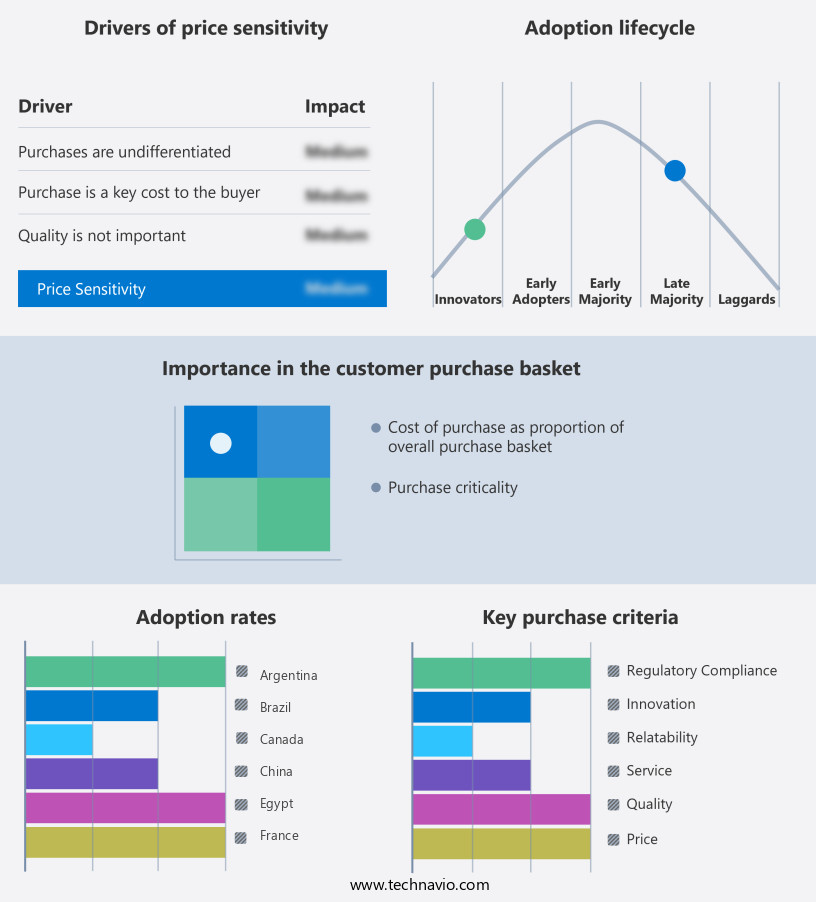
Customer Landscape of Pulse Oximetry Industry
Competitive Landscape
Companies are implementing various strategies, such as strategic alliances, pulse oximetry market forecast, partnerships, mergers and acquisitions, geographical expansion, and product/service launches, to enhance their presence in the industry.
American Diagnostic Corp. - This company specializes in pulse oximetry technology, providing innovative solutions through products like the Advantage 2200 and Diagnostix 2100. These devices offer accurate and reliable oxygen saturation and pulse rate measurement, contributing significantly to the healthcare industry's diagnostic capabilities.
The industry research and growth report includes detailed analyses of the competitive landscape of the market and information about key companies, including:
- American Diagnostic Corp.
- Contec Medical Systems Co. Ltd.
- Dragerwerk AG and Co. KGaA
- General Electric Co.
- Halma Plc
- Heal Force Biomeditech Holdings Ltd.
- ICU Medical Inc.
- Konica Minolta Inc.
- Koninklijke Philips NV
- Lepu Medical Technology Beijing Co. Ltd.
- Masimo Corp.
- Medical Information Technology Inc.
- Medtronic Plc
- Nihon Kohden Corp.
- Nonin Medical Inc.
- OMRON Corp.
- SCHILLER AG
- Shenzhen Mindray BioMedical Electronics Co. Ltd.
- Vyaire Medical Inc.
Qualitative and quantitative analysis of companies has been conducted to help clients understand the wider business environment as well as the strengths and weaknesses of key industry players. Data is qualitatively analyzed to categorize companies as pure play, category-focused, industry-focused, and diversified; it is quantitatively analyzed to categorize companies as dominant, leading, strong, tentative, and weak.
Recent Development and News in Pulse Oximetry Market
- In January 2024, Masimo Corporation, a leading pulse oximetry technology company, announced the FDA clearance and European CE mark approval for its Rad-97 pulse oximeter, featuring the innovative Rad-G sensor technology (Masimo Corporation Press Release, 2024). This new device offers noninvasive spot-check and continuous monitoring capabilities, expanding Masimo's product portfolio and strengthening its market position.
- In March 2024, Philips and Medtronic, two prominent players in the healthcare technology sector, entered into a strategic partnership to integrate Philips' pulse oximetry solutions with Medtronic's patient monitoring and remote care platforms (Philips Press Release, 2024). This collaboration aims to enhance patient care and improve clinical outcomes by providing seamless data exchange and analysis between devices.
- In May 2024, Nonin Medical Inc., a leading manufacturer of finger pulse oximeters, secured a significant investment of USD30 million in a Series D funding round, led by Siemens Healthineers (Nonin Medical Inc. Press Release, 2024). This investment will support the company's continued growth and innovation in the market.
- In April 2025, Contec Medical Systems, a global manufacturer of medical devices, received FDA clearance for its new Bluetooth-enabled finger pulse oximeter, the CS100N (Contec Medical Systems Press Release, 2025). This wireless device offers real-time monitoring and data transmission, making it an attractive option for remote patient monitoring applications and telehealth services.
Dive into Technavio’s robust research methodology, blending expert interviews, extensive data synthesis, and validated models for unparalleled Pulse Oximetry Market insights. See full methodology.
|
Market Scope
|
|
Report Coverage
|
Details
|
|
Page number
|
221
|
|
Base year
|
2024
|
|
Historic period
|
2019-2023 |
|
Forecast period
|
2025-2029
|
|
Growth momentum & CAGR
|
Accelerate at a CAGR of 8.5%
|
|
Market growth 2025-2029
|
USD 1355.6 million
|
|
Market structure
|
Fragmented
|
|
YoY growth 2024-2025(%)
|
7.7
|
|
Key countries
|
US, Germany, China, UK, France, Japan, Canada, South Korea, Italy, and India
|
|
Competitive landscape
|
Leading Companies, Market Positioning of Companies, Competitive Strategies, and Industry Risks
|
Request Free Sample
Research Analyst Overview
- In the dynamic and evolving landscape of patient monitoring systems, pulse oximetry technology continues to gain prominence as a crucial tool for oxygen saturation monitoring. Real-time monitoring of arterial oxygen saturation (SpO2) and heart rate (HR) has become an essential component of healthcare, particularly in respiratory care and critical patient settings. Sensor accuracy validation is a critical aspect of pulse oximetry, with ongoing research focusing on improving sensor technology to mitigate ambient light interference and enhance signal processing algorithms. Pulse rate variability, a measure of the variation in heart rate, is another emerging metric gaining attention for its potential in assessing patient condition.
- Real-time monitoring of respiratory rate detection, low perfusion, and motion artifact reduction are essential features that contribute to the clinical performance metrics of these devices. Calibration techniques and alarm thresholds are also under constant review to ensure optimal device functionality and user experience. Sensor lifespan and performance benchmarks are essential considerations for healthcare providers, with ongoing research focusing on enhancing sensor durability and minimizing power consumption. Multi-parameter monitoring, including heart rate and SpO2, is becoming increasingly common in patient monitoring systems, offering valuable insights into patient condition. Wireless connectivity and data logging capabilities are also crucial features, enabling seamless data transmission and analysis.
- Safety standards and maintenance procedures are essential aspects of these devices, with ongoing efforts to improve user interface design and troubleshooting guides. Plethysmography technology, a key component of pulse oximetry, continues to evolve, with advancements in photoplethysmography sensors and signal processing algorithms. These improvements aim to enhance sensor placement guidelines and reduce signal noise, ensuring accurate and reliable SpO2 measurements. In summary, the market is characterized by continuous innovation and improvement, with ongoing research focusing on enhancing sensor accuracy, clinical performance, and user experience. These advancements are essential for addressing the evolving needs of healthcare providers and improving patient care.
What are the Key Data Covered in this Pulse Oximetry Market Research and Growth Report?
-
What is the expected growth of the Pulse Oximetry Market between 2025 and 2029?
-
What segmentation does the market report cover?
-
The report is segmented by Product (Bedside/desktop pulse oximeters, Handheld pulse oximeters, Fingertip pulse oximeters, and Wrist-worn pulse oximeters), End-user (Hospitals and clinics and Alternative care settings), Distribution Channel (Offline and Online), and Geography (North America, Europe, Asia, and Rest of World (ROW))
-
Which regions are analyzed in the report?
-
What are the key growth drivers and market challenges?
-
Who are the major players in the Pulse Oximetry Market?
-
American Diagnostic Corp., Contec Medical Systems Co. Ltd., Dragerwerk AG and Co. KGaA, General Electric Co., Halma Plc, Heal Force Biomeditech Holdings Ltd., ICU Medical Inc., Konica Minolta Inc., Koninklijke Philips NV, Lepu Medical Technology Beijing Co. Ltd., Masimo Corp., Medical Information Technology Inc., Medtronic Plc, Nihon Kohden Corp., Nonin Medical Inc., OMRON Corp., SCHILLER AG, Shenzhen Mindray BioMedical Electronics Co. Ltd., and Vyaire Medical Inc.
Market Research Insights
- The market encompasses innovative technologies and applications, driven by the demand for accurate and reliable oxygen saturation measurement. Optical sensor technology, a cornerstone of this market, continues to advance, enabling clinical validation studies and refining data interpretation methods. Two significant developments illustrate this progress: precision medicine applications, such as sleep apnea diagnosis, have seen a 15% annual growth rate, while diagnostic accuracy in critical care applications approaches 99%. These advancements are fueled by the integration of pulse oximetry with electronic medical records, energy efficiency, and sensor miniaturization. Neonatal applications, cardiac monitoring, and anesthesia monitoring also benefit from these advancements, as do home healthcare applications and remote patient monitoring.
- Signal quality assessment, error detection algorithms, and sensor calibration methods ensure device reliability and user experience improvements. Pulse oximetry's role in diagnostic accuracy and wearable sensor design continues to expand, with power management circuits and algorithm optimization enabling new applications in physical activity tracking and surgical monitoring.
We can help! Our analysts can customize this pulse oximetry market research report to meet your requirements.
Get in touch
1 Executive Summary
- 1.1 Market overview
- Executive Summary - Chart on Market Overview
- Executive Summary - Data Table on Market Overview
- Executive Summary - Chart on Global Market Characteristics
- Executive Summary - Chart on Market by Geography
- Executive Summary - Chart on Market Segmentation by Product
- Executive Summary - Chart on Market Segmentation by End-user
- Executive Summary - Chart on Market Segmentation by Distribution Channel
- Executive Summary - Chart on Incremental Growth
- Executive Summary - Data Table on Incremental Growth
- Executive Summary - Chart on Company Market Positioning
2 Technavio Analysis
- 2.1 Analysis of price sensitivity, lifecycle, customer purchase basket, adoption rates, and purchase criteria
- Analysis of price sensitivity, lifecycle, customer purchase basket, adoption rates, and purchase criteria
- 2.2 Criticality of inputs and Factors of differentiation
- Overview on criticality of inputs and factors of differentiation
- 2.3 Factors of disruption
- Overview on factors of disruption
- 2.4 Impact of drivers and challenges
- Impact of drivers and challenges in 2024 and 2029
3 Market Landscape
- 3.1 Market ecosystem
- Parent Market
- Data Table on - Parent Market
- 3.2 Market characteristics
- Market characteristics analysis
4 Market Sizing
- 4.1 Market definition
- Offerings of companies included in the market definition
- 4.2 Market segment analysis
- 4.4 Market outlook: Forecast for 2024-2029
- Chart on Global - Market size and forecast 2024-2029 ($ million)
- Data Table on Global - Market size and forecast 2024-2029 ($ million)
- Chart on Global Market: Year-over-year growth 2024-2029 (%)
- Data Table on Global Market: Year-over-year growth 2024-2029 (%)
5 Historic Market Size
- 5.1 Global Pulse Oximetry Market 2019 - 2023
- Historic Market Size - Data Table on Global Pulse Oximetry Market 2019 - 2023 ($ million)
- 5.2 Product segment analysis 2019 - 2023
- Historic Market Size - Product Segment 2019 - 2023 ($ million)
- 5.3 End-user segment analysis 2019 - 2023
- Historic Market Size - End-user Segment 2019 - 2023 ($ million)
- 5.4 Distribution Channel segment analysis 2019 - 2023
- Historic Market Size - Distribution Channel Segment 2019 - 2023 ($ million)
- 5.5 Geography segment analysis 2019 - 2023
- Historic Market Size - Geography Segment 2019 - 2023 ($ million)
- 5.6 Country segment analysis 2019 - 2023
- Historic Market Size - Country Segment 2019 - 2023 ($ million)
6 Qualitative Analysis
- 6.1 The AI impact on Global Pulse Oximetry Market
7 Five Forces Analysis
- 7.1 Five forces summary
- Five forces analysis - Comparison between 2024 and 2029
- 7.2 Bargaining power of buyers
- Bargaining power of buyers - Impact of key factors 2024 and 2029
- 7.3 Bargaining power of suppliers
- Bargaining power of suppliers - Impact of key factors in 2024 and 2029
- 7.4 Threat of new entrants
- Threat of new entrants - Impact of key factors in 2024 and 2029
- 7.5 Threat of substitutes
- Threat of substitutes - Impact of key factors in 2024 and 2029
- 7.6 Threat of rivalry
- Threat of rivalry - Impact of key factors in 2024 and 2029
- 7.7 Market condition
- Chart on Market condition - Five forces 2024 and 2029
8 Market Segmentation by Product
- 8.1 Market segments
- Chart on Product - Market share 2024-2029 (%)
- Data Table on Product - Market share 2024-2029 (%)
- 8.2 Comparison by Product
- Chart on Comparison by Product
- Data Table on Comparison by Product
- 8.3 Bedside/desktop - Market size and forecast 2024-2029
- Chart on Bedside/desktop - Market size and forecast 2024-2029 ($ million)
- Data Table on Bedside/desktop - Market size and forecast 2024-2029 ($ million)
- Chart on Bedside/desktop - Year-over-year growth 2024-2029 (%)
- Data Table on Bedside/desktop - Year-over-year growth 2024-2029 (%)
- 8.4 Handheld - Market size and forecast 2024-2029
- Chart on Handheld - Market size and forecast 2024-2029 ($ million)
- Data Table on Handheld - Market size and forecast 2024-2029 ($ million)
- Chart on Handheld - Year-over-year growth 2024-2029 (%)
- Data Table on Handheld - Year-over-year growth 2024-2029 (%)
- 8.5 Fingertip - Market size and forecast 2024-2029
- Chart on Fingertip - Market size and forecast 2024-2029 ($ million)
- Data Table on Fingertip - Market size and forecast 2024-2029 ($ million)
- Chart on Fingertip - Year-over-year growth 2024-2029 (%)
- Data Table on Fingertip - Year-over-year growth 2024-2029 (%)
- 8.6 Wrist-worn - Market size and forecast 2024-2029
- Chart on Wrist-worn - Market size and forecast 2024-2029 ($ million)
- Data Table on Wrist-worn - Market size and forecast 2024-2029 ($ million)
- Chart on Wrist-worn - Year-over-year growth 2024-2029 (%)
- Data Table on Wrist-worn - Year-over-year growth 2024-2029 (%)
- 8.7 Market opportunity by Product
- Market opportunity by Product ($ million)
- Data Table on Market opportunity by Product ($ million)
9 Market Segmentation by End-user
- 9.1 Market segments
- Chart on End-user - Market share 2024-2029 (%)
- Data Table on End-user - Market share 2024-2029 (%)
- 9.2 Comparison by End-user
- Chart on Comparison by End-user
- Data Table on Comparison by End-user
- 9.3 Hospitals and clinics - Market size and forecast 2024-2029
- Chart on Hospitals and clinics - Market size and forecast 2024-2029 ($ million)
- Data Table on Hospitals and clinics - Market size and forecast 2024-2029 ($ million)
- Chart on Hospitals and clinics - Year-over-year growth 2024-2029 (%)
- Data Table on Hospitals and clinics - Year-over-year growth 2024-2029 (%)
- 9.4 Alternative care settings - Market size and forecast 2024-2029
- Chart on Alternative care settings - Market size and forecast 2024-2029 ($ million)
- Data Table on Alternative care settings - Market size and forecast 2024-2029 ($ million)
- Chart on Alternative care settings - Year-over-year growth 2024-2029 (%)
- Data Table on Alternative care settings - Year-over-year growth 2024-2029 (%)
- 9.5 Market opportunity by End-user
- Market opportunity by End-user ($ million)
- Data Table on Market opportunity by End-user ($ million)
10 Market Segmentation by Distribution Channel
- 10.1 Market segments
- Chart on Distribution Channel - Market share 2024-2029 (%)
- Data Table on Distribution Channel - Market share 2024-2029 (%)
- 10.2 Comparison by Distribution Channel
- Chart on Comparison by Distribution Channel
- Data Table on Comparison by Distribution Channel
- 10.3 Offline - Market size and forecast 2024-2029
- Chart on Offline - Market size and forecast 2024-2029 ($ million)
- Data Table on Offline - Market size and forecast 2024-2029 ($ million)
- Chart on Offline - Year-over-year growth 2024-2029 (%)
- Data Table on Offline - Year-over-year growth 2024-2029 (%)
- 10.4 Online - Market size and forecast 2024-2029
- Chart on Online - Market size and forecast 2024-2029 ($ million)
- Data Table on Online - Market size and forecast 2024-2029 ($ million)
- Chart on Online - Year-over-year growth 2024-2029 (%)
- Data Table on Online - Year-over-year growth 2024-2029 (%)
- 10.5 Market opportunity by Distribution Channel
- Market opportunity by Distribution Channel ($ million)
- Data Table on Market opportunity by Distribution Channel ($ million)
11 Customer Landscape
- 11.1 Customer landscape overview
- Analysis of price sensitivity, lifecycle, customer purchase basket, adoption rates, and purchase criteria
12 Geographic Landscape
- 12.1 Geographic segmentation
- Chart on Market share by geography 2024-2029 (%)
- Data Table on Market share by geography 2024-2029 (%)
- 12.2 Geographic comparison
- Chart on Geographic comparison
- Data Table on Geographic comparison
- 12.3 North America - Market size and forecast 2024-2029
- Chart on North America - Market size and forecast 2024-2029 ($ million)
- Data Table on North America - Market size and forecast 2024-2029 ($ million)
- Chart on North America - Year-over-year growth 2024-2029 (%)
- Data Table on North America - Year-over-year growth 2024-2029 (%)
- 12.4 Europe - Market size and forecast 2024-2029
- Chart on Europe - Market size and forecast 2024-2029 ($ million)
- Data Table on Europe - Market size and forecast 2024-2029 ($ million)
- Chart on Europe - Year-over-year growth 2024-2029 (%)
- Data Table on Europe - Year-over-year growth 2024-2029 (%)
- 12.5 Asia - Market size and forecast 2024-2029
- Chart on Asia - Market size and forecast 2024-2029 ($ million)
- Data Table on Asia - Market size and forecast 2024-2029 ($ million)
- Chart on Asia - Year-over-year growth 2024-2029 (%)
- Data Table on Asia - Year-over-year growth 2024-2029 (%)
- 12.6 Rest of World (ROW) - Market size and forecast 2024-2029
- Chart on Rest of World (ROW) - Market size and forecast 2024-2029 ($ million)
- Data Table on Rest of World (ROW) - Market size and forecast 2024-2029 ($ million)
- Chart on Rest of World (ROW) - Year-over-year growth 2024-2029 (%)
- Data Table on Rest of World (ROW) - Year-over-year growth 2024-2029 (%)
- 12.7 US - Market size and forecast 2024-2029
- Chart on US - Market size and forecast 2024-2029 ($ million)
- Data Table on US - Market size and forecast 2024-2029 ($ million)
- Chart on US - Year-over-year growth 2024-2029 (%)
- Data Table on US - Year-over-year growth 2024-2029 (%)
- 12.8 China - Market size and forecast 2024-2029
- Chart on China - Market size and forecast 2024-2029 ($ million)
- Data Table on China - Market size and forecast 2024-2029 ($ million)
- Chart on China - Year-over-year growth 2024-2029 (%)
- Data Table on China - Year-over-year growth 2024-2029 (%)
- 12.9 Germany - Market size and forecast 2024-2029
- Chart on Germany - Market size and forecast 2024-2029 ($ million)
- Data Table on Germany - Market size and forecast 2024-2029 ($ million)
- Chart on Germany - Year-over-year growth 2024-2029 (%)
- Data Table on Germany - Year-over-year growth 2024-2029 (%)
- 12.10 UK - Market size and forecast 2024-2029
- Chart on UK - Market size and forecast 2024-2029 ($ million)
- Data Table on UK - Market size and forecast 2024-2029 ($ million)
- Chart on UK - Year-over-year growth 2024-2029 (%)
- Data Table on UK - Year-over-year growth 2024-2029 (%)
- 12.11 France - Market size and forecast 2024-2029
- Chart on France - Market size and forecast 2024-2029 ($ million)
- Data Table on France - Market size and forecast 2024-2029 ($ million)
- Chart on France - Year-over-year growth 2024-2029 (%)
- Data Table on France - Year-over-year growth 2024-2029 (%)
- 12.12 Canada - Market size and forecast 2024-2029
- Chart on Canada - Market size and forecast 2024-2029 ($ million)
- Data Table on Canada - Market size and forecast 2024-2029 ($ million)
- Chart on Canada - Year-over-year growth 2024-2029 (%)
- Data Table on Canada - Year-over-year growth 2024-2029 (%)
- 12.13 Japan - Market size and forecast 2024-2029
- Chart on Japan - Market size and forecast 2024-2029 ($ million)
- Data Table on Japan - Market size and forecast 2024-2029 ($ million)
- Chart on Japan - Year-over-year growth 2024-2029 (%)
- Data Table on Japan - Year-over-year growth 2024-2029 (%)
- 12.14 South Korea - Market size and forecast 2024-2029
- Chart on South Korea - Market size and forecast 2024-2029 ($ million)
- Data Table on South Korea - Market size and forecast 2024-2029 ($ million)
- Chart on South Korea - Year-over-year growth 2024-2029 (%)
- Data Table on South Korea - Year-over-year growth 2024-2029 (%)
- 12.15 Italy - Market size and forecast 2024-2029
- Chart on Italy - Market size and forecast 2024-2029 ($ million)
- Data Table on Italy - Market size and forecast 2024-2029 ($ million)
- Chart on Italy - Year-over-year growth 2024-2029 (%)
- Data Table on Italy - Year-over-year growth 2024-2029 (%)
- 12.16 India - Market size and forecast 2024-2029
- Chart on India - Market size and forecast 2024-2029 ($ million)
- Data Table on India - Market size and forecast 2024-2029 ($ million)
- Chart on India - Year-over-year growth 2024-2029 (%)
- Data Table on India - Year-over-year growth 2024-2029 (%)
- 12.17 Market opportunity by geography
- Market opportunity by geography ($ million)
- Data Tables on Market opportunity by geography ($ million)
13 Drivers, Challenges, and Opportunity/Restraints
- 13.3 Impact of drivers and challenges
- Impact of drivers and challenges in 2024 and 2029
- 13.4 Market opportunities/restraints
14 Competitive Landscape
- 14.2 Competitive Landscape
- Overview on criticality of inputs and factors of differentiation
- 14.3 Landscape disruption
- Overview on factors of disruption
- 14.4 Industry risks
- Impact of key risks on business
15 Competitive Analysis
- 15.2 Company ranking index
- 15.3 Market positioning of companies
- Matrix on companies position and classification
- 15.4 American Diagnostic Corp.
- American Diagnostic Corp. - Overview
- American Diagnostic Corp. - Product / Service
- American Diagnostic Corp. - Key offerings
- SWOT
- 15.5 Contec Medical Systems Co. Ltd.
- Contec Medical Systems Co. Ltd. - Overview
- Contec Medical Systems Co. Ltd. - Product / Service
- Contec Medical Systems Co. Ltd. - Key offerings
- SWOT
- 15.6 General Electric Co.
- General Electric Co. - Overview
- General Electric Co. - Business segments
- General Electric Co. - Key news
- General Electric Co. - Key offerings
- General Electric Co. - Segment focus
- SWOT
- 15.7 Halma Plc
- Halma Plc - Overview
- Halma Plc - Business segments
- Halma Plc - Key news
- Halma Plc - Key offerings
- Halma Plc - Segment focus
- SWOT
- 15.8 ICU Medical Inc.
- ICU Medical Inc. - Overview
- ICU Medical Inc. - Product / Service
- ICU Medical Inc. - Key offerings
- SWOT
- 15.9 Konica Minolta Inc.
- Konica Minolta Inc. - Overview
- Konica Minolta Inc. - Business segments
- Konica Minolta Inc. - Key news
- Konica Minolta Inc. - Key offerings
- Konica Minolta Inc. - Segment focus
- SWOT
- 15.10 Koninklijke Philips NV
- Koninklijke Philips NV - Overview
- Koninklijke Philips NV - Business segments
- Koninklijke Philips NV - Key news
- Koninklijke Philips NV - Key offerings
- Koninklijke Philips NV - Segment focus
- SWOT
- 15.11 Masimo Corp.
- Masimo Corp. - Overview
- Masimo Corp. - Product / Service
- Masimo Corp. - Key news
- Masimo Corp. - Key offerings
- SWOT
- 15.12 Medtronic Plc
- Medtronic Plc - Overview
- Medtronic Plc - Business segments
- Medtronic Plc - Key news
- Medtronic Plc - Key offerings
- Medtronic Plc - Segment focus
- SWOT
- 15.13 Nihon Kohden Corp.
- Nihon Kohden Corp. - Overview
- Nihon Kohden Corp. - Business segments
- Nihon Kohden Corp. - Key offerings
- Nihon Kohden Corp. - Segment focus
- SWOT
- 15.14 Nonin Medical Inc.
- Nonin Medical Inc. - Overview
- Nonin Medical Inc. - Product / Service
- Nonin Medical Inc. - Key news
- Nonin Medical Inc. - Key offerings
- SWOT
- 15.15 OMRON Corp.
- OMRON Corp. - Overview
- OMRON Corp. - Business segments
- OMRON Corp. - Key news
- OMRON Corp. - Key offerings
- OMRON Corp. - Segment focus
- SWOT
- 15.16 SCHILLER AG
- SCHILLER AG - Overview
- SCHILLER AG - Product / Service
- SCHILLER AG - Key offerings
- SWOT
- 15.17 Shenzhen Mindray BioMedical Electronics Co. Ltd.
- Shenzhen Mindray BioMedical Electronics Co. Ltd. - Overview
- Shenzhen Mindray BioMedical Electronics Co. Ltd. - Product / Service
- Shenzhen Mindray BioMedical Electronics Co. Ltd. - Key news
- Shenzhen Mindray BioMedical Electronics Co. Ltd. - Key offerings
- SWOT
- 15.18 Vyaire Medical Inc.
- Vyaire Medical Inc. - Overview
- Vyaire Medical Inc. - Product / Service
- Vyaire Medical Inc. - Key offerings
- SWOT
16 Appendix
- 16.2 Inclusions and exclusions checklist
- Inclusions checklist
- Exclusions checklist
- 16.3 Currency conversion rates for US$
- Currency conversion rates for US$
- 16.4 Research methodology
- 16.7 Validation techniques employed for market sizing
- Validation techniques employed for market sizing
- 16.9 360 degree market analysis
- 360 degree market analysis
- 16.10 List of abbreviations







![]() Get the report (PDF) sent to your email within minutes.
Get the report (PDF) sent to your email within minutes.
Complimentary full Excel data with your report purchase.